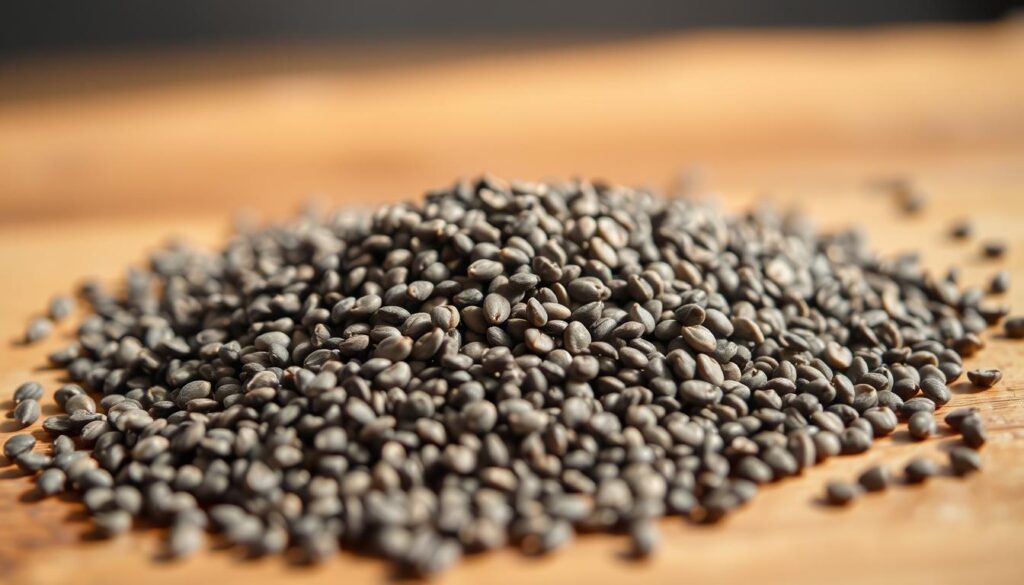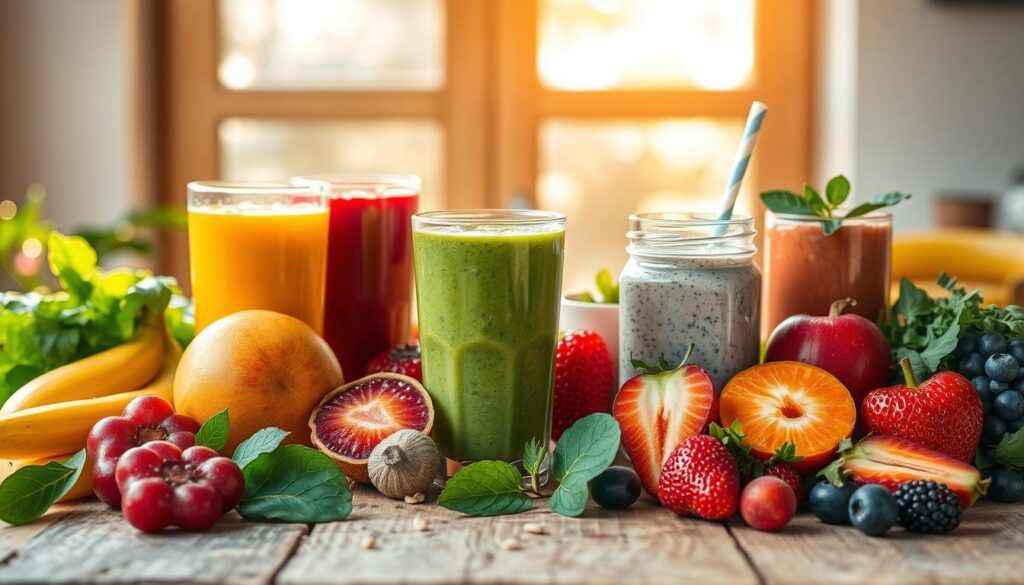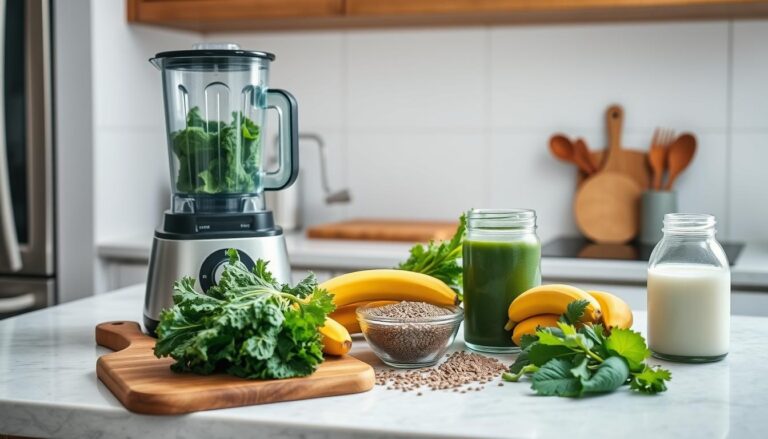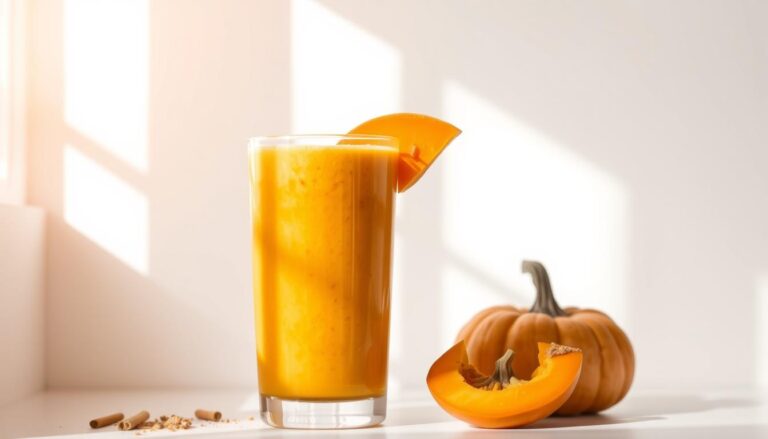Is a Smoothie Good for Breakfast when you follow smart rules? You can make a plant-based cup that fuels your morning without a sugar crash.
Keep portions small, add protein, fiber, and healthy fats, and skip juice or sweetened yogurt. That balance helps steady energy and supports weight loss goals when needed.
Tip: Aim for 15–30 g protein, toss in greens like spinach, and pick whole fruit over juice to cut added sugars.
Decide if the drink is a meal or a snack and match the cup size. Make-ahead packs save time: chill for one day or freeze for up to three months.
Ready to customize your vegan plan? Build a cup that fits your taste and targets using our smoothie generator: https://healthconservatory.com/smoothie-generator
Table of Contents
Key Takeaways
- Balance protein, fiber, and healthy fats to make a nutritious smoothie.
- Limit added sugar and avoid juice-heavy blends.
- Match cup size to meal or snack to control calories.
- Aim for 15–30 g protein at breakfast to stay full.
- Include vegetables like spinach to boost fiber and nutrients.
- Use the smoothie generator to build vegan options that fit your goals.
Is a Smoothie Good for Breakfast for vegans right now?
Your blend can be nourishing or sugary; the difference is in the recipe. Start by defining a healthy smoothie: low added sugar, enough protein, and plenty of fiber so you stay full through the morning.
What makes breakfast smoothies healthy or not
Dietitians warn that juice and flavored yogurts can push a drink into dessert territory. Large shop-sized cups may contain 20–25 teaspoons of sugar.
How vegan choices impact protein, sugar, and fiber
Choose unsweetened plant liquids like almond milk or soy milk, add plant protein powder or tofu, and toss in greens such as spinach. Whole fruits and seeds add fiber, which slows digestion and tames natural sugars.
| Liquid | Sweetness Risk | Protein Help |
|---|---|---|
| Unsweetened almond milk | Low | Low |
| Soy milk | Low | Moderate |
| Fruit juice | High | None |
Quick tip: Decide whether your drink is a meal or a snack that day and match portion size. Want help building one? Try our smoothie generator to customize ingredients and protein targets.
Key benefits of breakfast smoothies for your morning
Start the morning by building a cup that balances slow carbs, plant protein, and healthy fats. This approach helps you stay energized and reduces the urge to snack before lunch.
Steady energy with low-sugar fruits and fiber
Lean on berries and whole fruit rather than juice. Add oats, chia, or flax to boost fiber and slow digestion.
This mix keeps blood sugar steady and supports even energy through the morning.
Satiety from protein and healthy fats to avoid mid-morning crashes
Include plant protein like pea powder or hemp and a tablespoon of nut butter or seeds. Protein plus fats increase fullness so you skip the mid-morning slump.
Micronutrient boost from greens and vegetables
Spinach or kale blend easily and add iron, folate, and potassium with very few calories. Frozen fruit or a small banana improves texture without extra syrups.
Quick note: If your drink leaves you hungry, raise protein or fiber or pair it with a small solid bite. And yes — Is a Smoothie Good for Breakfast can be true when you build it this way using plant-based ingredients like hemp and seeds.
Common mistakes that turn a healthy smoothie into a sugar bomb
A few common choices quickly load your morning blend with hidden sugars. Be aware: one large blend with orange juice, frozen fruit, and flavored yogurt can equal 20–25 teaspoons of sugar. That same oversized cup may deliver one-third to half of your daily calories without you noticing.
Relying on juice and sweetened milks
Swap juice for whole fruit to keep fiber and slow sugar absorption. Choose unsweetened almond or soy milk, plain water, coconut water, or ice instead of flavored plant milk.
Adding syrups, honey, or too many sweet add-ins
- The quickest path to excess sugar is pouring in syrups, honey, or maple syrup when ripe fruit already provides sweetness.
- Limit superfood boosts to one or two so you don’t add hidden calories.
- If you want warm sweetness, a pinch of cinnamon adds flavor with no sugar.
- Thin too-thick blends with water, ice, or coconut water rather than more juice.
Tip: Read labels on plant milks and set a realistic serving size to protect your weight goals.
Portion control: match your cup size to snack or meal
Portion control starts with naming the purpose: snack or full meal, then match the cup and calories to that goal.
Decide whether this will replace your morning meal or act as a light snack. For a meal, add more protein, fiber, and healthy fats so you stay full. For a snack, keep the cup smaller and use fewer ingredients.
How to size a snack cup versus a meal cup
Many home blenders hold up to two liters, so portion creep is common. Use measuring cups or a kitchen scale as you add each ingredient to avoid oversized servings.
Keep one set of smaller cups for snacks and one set of larger cups for meals. Track the calories of your go-to mix once so you can repeat it with confidence.
Pre-measured packs to save time and calories
Make freezer packs with measured fruit, greens, and seeds. Stash meal-size packs and snack-size packs separately to save time and prevent guesswork.
- Tip: Match liquid volume to purpose — less for thicker, meal-style blends; more for lighter sips.
- Consider a small solid side if liquids alone leave you hungry.
- Consistency beats complexity: simple, well-measured ingredients create a reliable morning routine.
Fruit the right way: keep it balanced
Treat fruit as an ingredient, not the whole cup. Dietitians recommend capping total fruits at about 1 to 1.5 cups per blend to keep calories and sugar reasonable. Berries are the top choice: they add fiber and antioxidants with less sugar per serving.
Ideal portions and choices
Use mostly berries and add half a banana for creaminess. A half banana adds sweetness without overshooting calories.
Managing blood sugar while keeping natural sweetness
Pair fruit with fiber from greens, oats, or seeds to blunt sugar spikes. Avoid combining multiple high-sugar fruits or adding juice.
- Cap fruits at 1–1.5 cups per cup-sized blend.
- Prioritize berries for fiber and lower sugar.
- Use half a banana for texture and mild sweetness.
- Taste before sweetening—ripe fruit often suffices.
- Pre-portion fruit into freezer bags to keep portions consistent.
Quick tip: If you exercise, time slightly larger fruit portions around workouts for quick fuel. The aim is flavor plus fiber, not maximum sweetness.
Power up with plants: vegetables and greens in your blender
Pack your morning cup with leafy greens and low-sugar vegetables to boost micronutrients without extra calories. This approach helps you get vitamins, minerals, and fiber while keeping sweetness in check.
Spinach, kale, and vegetables that disappear into flavor
Spinach blends almost invisibly and adds iron and folate; start with a big handful and you won’t notice the taste. Kale offers Vitamin K and extra fiber; strip thicker stems or use baby kale for a milder texture.
Keep frozen greens ready so tossing them into the blender is effortless. Vegetables like cucumber, zucchini, and cauliflower add volume and creaminess with minimal sugar.
Green smoothie ideas that stay light on sugar
Pair greens with berries, a wedge of citrus, or a small slice of pineapple to keep sweetness low. Try spinach plus cucumber and lemon for an ultra-low-sugar base that still tastes bright.
- Start with one packed cup of greens and work up as your taste adapts.
- Blend greens with liquid first for a smoother texture, then add fruit and seeds.
- Rotate greens (spinach, kale, arugula) to vary nutrients across the week.
Tip: Use fresh herbs like mint to brighten flavors without adding sugar, and consider beets or carrots sparingly for color and natural sweetness when you want it.
Protein made vegan: satisfying options for breakfast smoothies
Aim for a protein-rich base to keep hunger at bay through the morning. For most people, 15–30 grams per serving is the practical target. Your exact goal depends on cup size and activity level.
Simple combos work best. One scoop of protein powder plus 8–12 ounces of soy milk often hits the lower end of the range. If you train hard, push toward 25–30 grams.
Reliable vegan sources and measures
- Plant protein powder — 1 scoop ≈ 15–20 g protein (check label).
- Soy milk — 8 oz ≈ 7 g protein; use instead of almond milk to boost totals.
- Hemp seeds — 2 tbsp ≈ 6–7 g protein plus healthy fats.
- Chia or flax — add fiber and 2–4 g protein while supporting texture.
- Silken tofu or soy yogurt — 1/2 cup adds creaminess and 7–10 g protein.
| Ingredient | Typical serving | Protein (g) |
|---|---|---|
| Plant protein powder (scoop) | 1 scoop | 15–20 |
| Soy milk | 8 fl oz | 7 |
| Hemp seeds | 2 tbsp | 6–7 |
| Silken tofu | 1/2 cup | 7–10 |
Practical tips: Read labels to avoid added sugars, balance protein with fiber to extend fullness, and blend well to avoid grittiness. Log combos you like so you can repeat results quickly.
Healthy fats and fiber to keep you full

Smart fats and soluble fiber lengthen fullness, steady blood sugar, and lower the urge to snack. Use measured portions so calories don’t creep up.
Practical portions: one tablespoon is the rule of thumb. Add one tablespoon of chia seeds or ground flax to raise fiber and support digestion. One tablespoon of almond or peanut butter adds creaminess, healthy fats, and staying power.
Include hemp for extra protein and omega fats, and toss in a small scoop of oats to boost soluble fiber and thicken texture. Rotate your seeds during the week to vary nutrients.
- Add no more than one or two calorie-dense fats per cup to avoid excess calories.
- Blend longer when you add seeds so texture stays smooth.
- Measure each spoonful if weight goals matter—small changes add up.
Tip: Pair fats and fiber with protein to maximize satiety. These measured add-ins make your morning smoothie feel like a real, lasting meal without extra sugar.
Choose the right liquid: almond milk, soy milk, coconut water, or water
Pick a liquid that supports your goals—low sugar, enough protein, and the texture you like. The base changes sweetness, calories, and how filling your cup becomes.
When to use unsweetened almond milk vs. soy milk
Choose unsweetened almond milk when you want a creamy, low-calorie base that keeps sugar in check. It blends well with berries and greens and helps keep calories low.
Pick soy milk when you need more protein from your liquid without changing flavor much. Soy gives extra grams of protein so your drink feels more like a true meal.
Using coconut water or plain water to cut calories
Use coconut water or plain water to lighten texture and lower calories on lower-energy days. Coconut water adds mild sweetness and electrolytes; plain water keeps the blend neutral and lowest in calories.
“Keep ‘unsweetened’ on the label—many plant milks add sugars that undermine your goals.”
Practical tips:
- Start with less liquid for thicker blends and add until you like the feel.
- Use just a splash of juice for flavor and rely on whole fruit for fiber.
- Make ice cubes from unsweetened almond milk to chill and creamify without dilution.
Match your liquid to the day: choose almond milk for low calories, soy milk for protein, and coconut water or water when you want a lighter option.
Make-ahead strategies for busy mornings
Save time by prepping once and enjoying ease all week. Pre-portion ingredient packs so you dump, blend, and go.
Overnight fridge storage and freezer tips
Blend at night and store in an airtight jar in the fridge for up to one day. Fill the cup to the top to limit oxidation and keep flavor fresh.
Freeze full jars up to three months. Thaw overnight in the fridge and either stir or give a quick re-blend before leaving.
Blending smoother with frozen fruit and prepped greens
Use frozen fruit and prepped greens to speed mornings. If your blender is modest, add frozen items slowly and pour in a splash of unsweetened almond liquid to help blades move.
Quick wins:
- Pre-portion mixes with measured seeds like hemp, or make a chia layer ahead of time.
- Label packs with date and flavor to rotate stock.
- Keep simple add-ins by the counter so you waste no minutes hunting ingredients.
Routine wins: Weekly prep turns a rushed morning into a reliable, nutrient-rich smoothie ritual you can stick with.
Equipment essentials and simple hacks
Good gear turns a rushed morning into a simple, repeatable routine. Choose tools and small habits that save you time and improve texture without extra effort.
High-powered vs. economical units and how to adapt
High-powered blenders yield ultra-smooth results for seeds, greens, and frozen fruit. They cut blending time and reduce grainy bits.
If you use a budget blender, add liquid first, then pulse in frozen items slowly. Short bursts grind seeds better than long runs and prevent motor strain.
Keep blades sharp and gaskets clean. Regular maintenance saves repair time and keeps your results consistent.
Travel hacks: straws, cups, and workflow
Use stainless steel straws for a colder, more refreshing sip and to avoid disposable plastics. Opaque cups help hide green color if that puts you off early in the day.
- Batch-blend greens with liquid, freeze as cubes, and drop them in for speed.
- Pre-chill your cup and keep a mini spatula to capture every last drop.
- Set up a compact “smoothie station” with measured ingredients to streamline mornings.
List of vegan breakfast smoothie ideas you can blend today

Blend these combos in under a minute and still hit protein and fiber targets. Each idea stays plant-based and keeps added sugar low. Pre-portion frozen fruit and seeds to speed assembly.
Berry, chia, and mint with almond milk
Blend 1 cup mixed berries, 1 tbsp chia seeds, a few mint leaves, and 8 oz almond milk. This mix gives high fiber and a refreshing finish. Add half a banana for creaminess if you like.
Tropical chia with cashew or almond milk
Soak 2 tbsp chia seeds overnight in plant milk, then blend with mango and pineapple. The result is spoonable and sweet without syrups. Toss in kale or hemp for extra minerals.
Green pineapple-coconut water spinach smoothie
Combine 1 packed cup spinach, 1/2 cup pineapple, and coconut water. This green smoothie stays modest in sugar and tastes bright. Use half a banana to smooth texture, not to spike sweetness.
Chocolate-berry protein with plant protein powder
Mix plant protein powder, 1 tbsp cocoa, frozen fruit, and half a banana. It tastes like dessert while delivering breakfast-worthy macros. Sprinkle cinnamon to amp flavor without added sugar.
| Recipe | Key add-in | Texture | Quick tip |
|---|---|---|---|
| Berry, chia, mint | Chia seeds | Lightly thick | Use almond milk to thin |
| Tropical chia | Soaked chia | Pudding-like | Soak overnight |
| Green pineapple-spinach | Spinach | Bright & thin | Keep pineapple modest |
| Chocolate-berry protein | Protein powder | Rich & creamy | Half banana for creaminess |
Breakfast smoothies for weight loss without sacrificing flavor
You can trim calories without losing taste by anchoring your morning drink on protein and bulky, low-calorie ingredients.
Low-calorie, high-protein, high-fiber building blocks
Use a protein anchor that gives 15–30 g per serving so your blend works like a meal, not a snack.
Add fiber-rich ingredients such as oats, flax, or chia seeds to slow digestion and keep hunger away.
Stir in extra greens and low-sugar vegetables to add volume without upping calories or carbs.
Smart swaps to reduce added sugar and keep portions in check
Avoid juice and sweetened plant milks; choose water, coconut water, or unsweetened plant milk instead to cut sugar and overall calories.
Favor berries and citrus for bright flavor, and skip extra sweeteners. Measure ingredients and pick a smaller cup when this is a snack.
- Protein + fiber: build blends around protein and at least one fiber boost.
- Swap liquids to save calories and reduce added sugar.
- Use seeds like chia seeds or ground flax for fullness with minimal calories.
- Track your favorite mixes so you can repeat blends that support weight goals.
“Done right, this approach makes morning drinks a sustainable tool for weight management.”
Is a Smoothie Good for Breakfast: how to build the perfect vegan blend
Build a reliable recipe with five simple layers so your morning cup delivers nutrients, not sugar. Follow the order below to stay balanced and taste great every day.
Base formula: liquid, protein, fruits, greens, and add-ins
Start with your chosen liquid—unsweetened almond milk or water work well. Add a protein source next so it mixes evenly.
Use measured fruits (1–1.5 cups), favoring berries and one small banana for body. Toss in a big handful of spinach or kale for fiber and vitamins.
Limit add-ins to one or two: chia, oats, or nut butter. Add plant protein powder or silken tofu when you need 15–30 g protein.
Blend from low to high and scrape down the sides once before finishing. Store prepped packs in the freezer for quick mornings.
Flavor boosters like cinnamon, vanilla, and citrus
Use small flavor hits to avoid sugar. A dash of cinnamon, a drop of vanilla extract, or lemon zest lifts flavor without added sweeteners.
Keep juice to a splash if you must, and rely on whole fruit for sweetness. Log your favorite ratios so you can reproduce the perfect cup every time.
“Follow the five-part formula and your morning blend will fuel the day without sugar overload.”
Find your perfect morning smoothie now
Build a personalized cup in minutes that fits your schedule and nutrition goals. Meal-prepping and customization make it easier to stick with healthy habits and control sugar, fiber, and protein every day.
Use our smoothie generator to create vegan breakfast smoothies you’ll love
Try the tool to personalize ingredients, macros, and portion size. Choose dairy-free bases, plant proteins, and seed blends that match workouts or light mornings. Save favorites so you can repeat them any time.
- Create your ideal morning smoothie in minutes with our vegan-friendly smoothie generator.
- Personalize liquid, protein, fruits, greens, and add-ins to match taste, macros, and schedule.
- Build a breakfast smoothie for busy days or a post-workout morning smoothie with extra protein.
- Export ingredient lists to pre-portion for the week and save precious time.
- Pick low-sugar, fiber-forward options tailored to your goals and preferences.
Start now: Share favorite recipes with friends so healthy mornings become simple to keep, and check back as new vegan flavors and seasonal picks are added each day.
Conclusion
Finish strong: keep sugar low, aim for 15–30 g protein, and anchor blends with greens like spinach. Use measured fruit and unsweetened milk so sweetness comes from whole ingredients rather than juice or maple syrup.
Control portions to match a meal or snack. Build in fiber every time to steady energy through the day. Homemade prep and make-ahead packs (one day refrigerated, longer frozen) keep results consistent.
Is a Smoothie Good for Breakfast? Yes—when you design a healthy smoothie that balances protein, fiber, and real fruit.
Try our generator to personalize recipes and save favorites: https://healthconservatory.com/smoothie-generator





